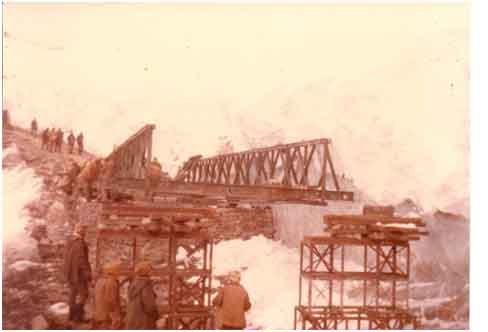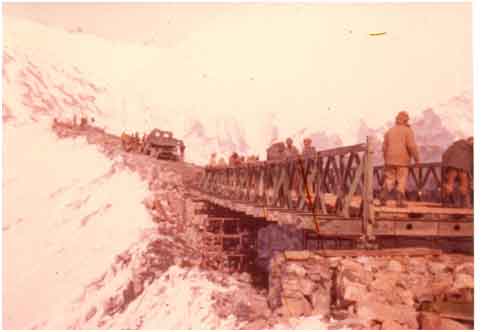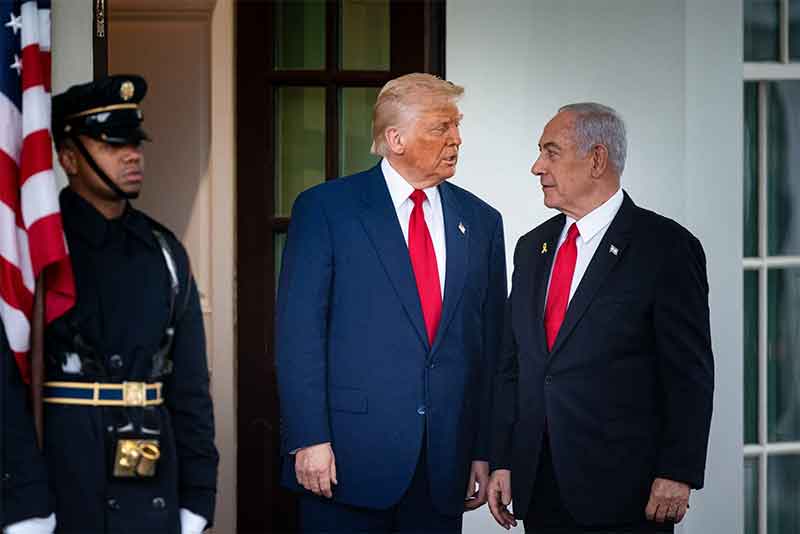The importance of a bridge is usually according to its dimensions or its carrying capacity. This account concerns the events that led to the construction of a military (Bailey) bridge insignificant in its dimensions or load capacity, its construction under exceptional circumstances, and how it became important.
Prelude
April 1982. I joined 16 BRTF in Ladakh to take over command from Lt Col (later Brigadier)S.M.R.Nair, who briefed me about the work, achievements and challenges in its area of responsibility. 16 BRTF of those days had an extensive road sector with many “choke points”, one of which was an ice body, the so-called glacier, situated on Road Leh-Chalunka just north of Khardungla (altitude 5,603-m) which is 39-km from Leh. The entire road was unsurfaced and in most places, just wide enough for one-way movement of the army’s 3-ton lorries. The road over Khardungla between South Pulu and North Pulu was kept open between May and October every year only to army vehicles – civilian vehicles did not operate because of the tortuous and risky passage. It took a light vehicle like a Nissan Jonga about seven jolting, dusty hours to cover the distance of 124-km between Leh and Hunder in the Shyok valley.
The road stretch passing over this ‘glacier’ at 5,580-m altitude, was 80-m long, but due to loss of about 40% of rated engine power due to altitude and wheels slipping on the ice, vehicles could not cross it without the help of a bulldozer or recovery vehicle winch at both ends of the glacier. Each crossing was time-consuming, and only 5 to 6 army 3-ton lorries could manage to pass per day each way. Further, the roadway width appeared to be gradually reducing, making vehicle passage risky. With the passage of even this minimal traffic over the years, and boulders and rubble being dumped on the ice to provide better wheel traction, the ice body had developed a depression or dip in the road surface, making it difficult and risky even to winch vehicles into and out of the dip.

With the road virtually unusable, the army’s growing operational commitments required increased operational and logistic loads to be airlifted at enormous expense.
In the summer of 1980, glaciologists from the Geological Survey of India (GSI) had been called to study the glacier and render expert advice regarding its stability. They made a brief site visit and reported that the “ice body” was “in a state of flow”, and the only solution was to realign a portion of the road to bye-pass it. The time for completion of the bye-pass was estimated at five years due to low machine output on account of high altitude, and snow and ice making formation cutting work possible for barely 3-4 months in a year. On the basis of the experts’ report, a work estimate for construction of a new road to bye-pass the glacier at cost of Rs.45 lakhs, had been prepared.
A suggestion re-considered
Even as the sanction for the work was awaited, the trafficability over Khardungla had further deteriorated, and with increased operational commitment, the load transportation requirement had increased. This rapidly worsening situation placed immense pressure on 16 BRTF to find an immediate solution to the problem of trafficability. It was clearly necessary to take a fresh look at the problem, and informal discussions to find a temporary solution were reckoned to be a good start point.
During one such ‘chatting session’, it came to light that, following the glaciologists’ visit, when the matter was being tossed about in the Officers’ Mess one evening, an officer’s wife had suggested constructing a bridge over the glacier. Considering the experts’ view, this was apparently considered flippant, and she had been pooh-poohed as impractical. But in the hot-seat in May 1982, and pressed with the urgency of the situation, launching a Bailey bridge across the glacier appeared to be a solution worth re-considering.
The opinion from the ground

Reconnaisance of the road slopes and horizontal curve geometrics on both sides of the North-facing glacier revealed that launching a Bailey bridge to span across it was definitely not possible. And resting the bridge on the ice body itself to only span across the depression in the ice surface was also considered impossible by experienced hands, because glaciologists had declared the glacier to be “in a state of flow”. This opinion was strengthened by reports from GREF Pioneers working on the ground that the glacier was moving, because the road width was observed to be gradually reducing. This was being overcome by manually hacking the ice face with pickaxes to widen the road (since the bulldozer blade could not make even a dent in the hard ice) so that the vehicle body would not accidentally strike it. They also pointed to the wreckage of vehicles which had fallen into the valley when moving across the glacier, because the body of the vehicle had struck the ice face, and the jerk had caused the vehicle to slip on the ice, slide off the road, and plunge down the slope.
Experts are not always right
Periodic observations over about 10 weeks, of three pegs in a straight line, two driven on hard ground and one on the ice, remaining in line, and the simple check that the centre lines of the road on ground and on the ice showed no lateral displacement, conclusively showed that the ice body was not moving. Also, careful observation showed that reducing roadway width was not due to movement of the ice body, but because water from melting ice on the upper sloping ice face was re-freezing on the vertical ice face of the road cut, which received no sunlight. I was convinced that the opinion of GSI glaciology experts regarding the glacier being in a “state of flow”, based on their brief site visit and the reports that the roadway width was reducing, was in error. Belief in this reality contrary to expert opinion, was central to the design and construction of the bridge. However, even if constructing a bridge was possible since the ice body was not moving, there were other problems to be addressed.
Practical solution
The proposal of constructing a Bailey bridge resting on ice and spanning across the depression in the road surface, was questioned by the team-on-the-ground, quoting the experts’ “state of flow” opinion. This called for explaining how simple engineering observations demonstrated that the “glacier” was really an unmoving ice body, and also explaining how the gradually reducing roadway width did not mean that the ice body was moving.
Questions of whether the ice would bear the weight of the bridge and vehicles moving across it without melting under pressure and/or cracking, were answered on the strength of Military Engineering Vol.III (Bridging), which records the Russians’ construction of a bridge on the ice of frozen Lake Ladoga every November and dismantling it before the spring thaw, for three successive winters of the German army’s seige of Leningrad during World War 2. Simple calculations established the minimum bearing capacity of ice as being far in excess of any possible loading including a generous factor of safety. Thus, the practicality of a bridge resting on ice was established. It was late July 1982.
Burden of responsibility
The thinking in 16 BRTF was oriented to constructing a bridge resting on ice, and it was time to obtain the permission of the Chief Engineer at Srinagar. However, it was not possible to convince the Chief Engineer or his staff, who were influenced by the “state of flow” opinion of GSI glaciologists, regarding the stability of the ice body and a bridge on it. They retained the view that constructing a bridge was risky, if not foolhardy. Thus, armed with a personal belief in the stability of the ice body and the viability of a bridge founded on it, the hard decision of going contrary to expert opinion for an emergency work of an unconventional and risky bridge launch, was taken to solve the trafficability problem over Khardungla. It was early August 1982.
Plans are useless without team competence
The road sector came under 54 RCC / 168 FC Pl ably commanded by Maj S.Ramaswamy (Ramu, to his friends) and AEE(M) H.S.(Harry)Rakhraj respectively. Ramu conducted detailed bridge reconnaissance to show that a 90-ft single-single (SS) Bailey bridge would serve the purpose. He also proposed bridge abutments built from stones wrapped in wire crating, resting on ice. In place of cement which would not set at low temperatures, with sapper innovativeness he proposed pouring water which would freeze and bind the stones together to make monolithic abutments.
Ramu, an accomplished leader and team-builder, combined efficiency and toughness with genuine understanding and the personal touch. Harry was another go-getter, extremely tough, solid and dependable. Ramu and Harry along with an enthusiastic Sapper JCO, Nb Sub P.Angamuthu, and GREF Pioneers (all aged around 45 years and with no experience of handling Bailey equipment) drawn from 1594 and 1601 GREF Pnr Coys, comprised the bridging team.
Since at that time all Bailey equipment in 16 BRTF sector was committed on ground with none held in stock, Ramu had to rustle up Bailey components by dismantling small bridges from within his road sector, and moving them up to Khardungla.
The reader may well wonder why so much is being made of constructing a mere 90-ft SS Bailey bridge which could, in ordinary circumstances, be entrusted to a Sapper NCO. The reason is that this bridge was constructed under multiple constraints, all of which were overcome by the ingenuity and careful work by Ramu and his team.
Restrictions and constraints
The site restrictions were multiple. Bridging components had to be placed strung out on the road side as the road was narrow, requiring manual carry of heavy components over 50-metres at high altitude by inexperienced men who were already in their forties. There was severely restricted back space (only 30-ft) available for construction, making conventional construction and launching of a Bailey bridge impossible.

Therefore intermediate temporary piers were constructed on the ice surface, using steel bridging cribs, Bailey transoms and wooden sleepers, with plain rollers mounted on top. The two piers, located 30-ft from the launching rollers on the home bank, were braced together, and their bases restrained from sliding on the ice by pickets driven into the ice. To make matters worse, it was a downward-slope launch and launching links to construct the “nose bay” were not available. This called for great care in setting out and launching, so that the leading bridge girders landed very gently on the pier rollers.
Construction
28 August 1982. The difficult nitty-gritty of logistics – planning and positioning stores and organizing work, making changes to standard procedures and bridge construction drills for untrained, inexperienced troops – and preparatory work was taken up enthusiastically, yet carefully and systematically, by Harry and Angamuthu under Ramu’s leadership and directions. Wire-crated dry stone masonry abutments (1.2-m high, 4.8-m wide, 1.8-m deep) were constructed, and the vertical ice face was dressed to achieve full road width and more importantly, permit launching of the bridge without transoms fouling with the ice face. This had taken three days of unremitting work in the most trying circumstances.
With only 30-ft of backspace available, it was not possible to follow normal procedures of providing adequate counterweight until the bridge tipped onto the intermediate pier rollers. Ramu, as innovative as ever, had additional transoms placed in the bays behind the launching rollers and had them shifted rearwards as the bridge was boomed out.

The temporary piers were a constant source of anxiety during launching because they were merely resting on ice, and the smallest jerk while launching the bridge could dislodge them, with disastrous consequences to men and equipment. It was imperative to eliminate all jerks when the bridge was approaching the temporary pier, and later when the bridge was running on the pier rollers, due to its rather precarious foundation on ice. Thus, booming-out the bridge was done very, very slowly, often as little as 6-inches at a time, to check that transoms did not foul with the ice face, sway braces did not foul with the rollers, and adequate counterweight was ensured. [ Indeed, when the lead girder touched down on the intermediate pier and the pier rocked ever so slightly, everybody present gasped!
All activities were slow because the GREF Pioneers were unfamiliar with Bailey equipment and construction, had to carry heavy components a distance of about 50-m, and worked with reduced oxygen due to high altitude, and sub-zero temperature due to the wind chill effect.

Starting work at 0700 hrs, the bridge touched the far bank rollers at around 1600 hrs. The bridge was jacked down, the temporary piers dismantled, and rough earth ramps built, so it was only around 1930 hrs, that a light vehicle was crossed over the bridge to mark completion of the task. The whole operation had lasted four days, and this was possible only because of Ramu and his marvellous team who had worked efficiently under exceptionally arduous conditions.
The features that made this bridge a reality to solve the problem of trafficability over Khardungla, were the concept that overcame adverse expert opinion, the command and technical risk involved in the decision to implement the concept, and the successful execution of the concept under exceptionally difficult circumstances and site conditions by Ramu and his team.
Serendipity

When we were back in camp and the team met for debriefing after the task was completed, someone remarked that this was perhaps the highest altitude motorable bridge. And so it was that serendipitously, a mere 90-ft SS Bailey bridge constructed to solve a problem, “accidentally” and fortuitously became the highest altitude bridge [Note 1]. Later it was discovered (more serendipity!) that besides being the highest altitude motorable bridge, this bridge also had the engineering distinction that it was a semi-permanent bridge across an ice body, with its foundations on ice.
Sequel
AEE (M) H.S.Rakhraj and Nb Sub P.Angamuthu were awarded the BRDB Commendation Card and the COAS Commendation Card respectively, for their roles in the construction of the bridge. Maj S.Ramaswamy was awarded the Visishta Seva Medal for distinguished service concerning this bridge and other works in his very difficult high altitude road sector, which improved communications.

Army convoy traffic over Khardungla increased manifold, saving most of the enormous recurring cost of airlifting military stores and even personnel . The bridge enabled winter observation of the ice body and, starting with the winter of 1983-84, the road across Khardungla was kept open during winter also, with its huge military and civil benefit. The J&K government civil supplies department was able to provide food and fuel to the people, and projects for telecommunications, power and other infrastructure were initiated, with trade and commerce in the hitherto cut-off area receiving huge impetus.

The work estimate for realignment of the road died a natural death, and in appreciation of the work, the Chief Engineer’s office designed Project Beacon’s greeting card for New Year 1983 with a photograph of the bridge on it.
Technical papers were published in premier international journals – The Journal of Glaciology in 1985 [Ref.1], and American Society of Civil Engneers (ASCE) Journal of Construction Engineering in 1986 [Ref.2]. The bridge-on-ice was also reported in an international seminar in 1991 [Ref.3].
In 1985, the bridge was delaunched and re-constructed as a 110-ft DS BB anchored with SWR to the mountain-side against shifting due to sloughing snow from the ice body above it. Notwithstanding this safety measure, two bridges were lost when hit by snow avalanches, but each time a new bridge was constructed.
In keeping with the recession of glaciers all over the Himalayas, this ice body also gradually ablated over the years, and in January 1995 it became possible to replace the bridge, lost in an avalanche, with a stone causeway. Today, the causeway serves quite well, and the highest altitude motorable bridge which was in service for about 13 years, from August 1982 to January 1995, is only a memory refreshed by pictures, or its scale model in 16 BRTF.
References:
- Vombatkere, G.; “On the Long-term Behaviour of Glacial Ice under Moving Traffic Loads – a Case Study”; Journal of Glaciology, International Glaciological Society, Cambridge, U.K.; Vol.31, No.109, 1985, pp.369-371.
- Vombatkere, S.G.; “Bridge resting on an Ice Body at High Altitude”; Journal of Construction Engineering and Management, American Society of Civil Engineers; 112, No.2, Jun 1986, Paper No.20695, pp.287-296.
- Vombatkere, S.G.; “Stability of a Bridge on Ice”; International Conference on Steel and Aluminium Structures, Singapore, 22-24 May 1991, sponsored by The International Association for Bridge and Structural Engineering, The Institution of Civil Engineers [London], The Institution of Structural Engineers [London], and The Steel Construction Institute [UK]; Elsevier Publishing ; Proceedings pp.980-988.
- The Guinness Book of Records, 1991; 95.
- The Limca Book of Records, 2004; 95.
Note 1: A wag defined “serendipity” as finding a book which you misplaced days ago when you were looking for your spectacles misplaced more recently. But more seriously, the first noted use of “serendipity” in the English language was by Horace Walpole (1717–1797). ”Serendipity” (pronounced as [ˌsɛr ənˈdɪp ɪ ti] means making desirable discoveries by accident, “fortuitous happenstance” or “pleasant surprise”. The notion of serendipity is a common occurrence throughout the history of scientific innovation. One aspect of Walpole’s original definition of serendipity, often missed in modern discussions of the word, is the need for an individual to be “sagacious” enough to link together apparently innocuous facts in order to come to a valuable conclusion.
S.G.Vombatkere, 30th Regular Course, was commissioned as Second Lieutenant into the Corps of Engineers (Madras Sappers) on 11 December 1962. He served in troops, MES and BRO appointments. President of India awarded him Visishta Seva Medal in 1993 for distinguished services rendered in Ladakh. He holds a M.E degree with distinction in structural engineering from University of Poona (1974), and PhD in Civil structural dynamics from I.I.T., Madras (1987). He retired in September 1996 in the rank of Major General from the appointment of ADG DV in Army HQ AG’s Branch. He is settled in Mysore, Karnataka, where he is engaged in voluntary social work and activism. He writes on development-related and strategic issues in leading print and internet journals. He is Adjunct Associate Professor in International Studies of the University of Iowa, USA.
E-mail:<[email protected]










































